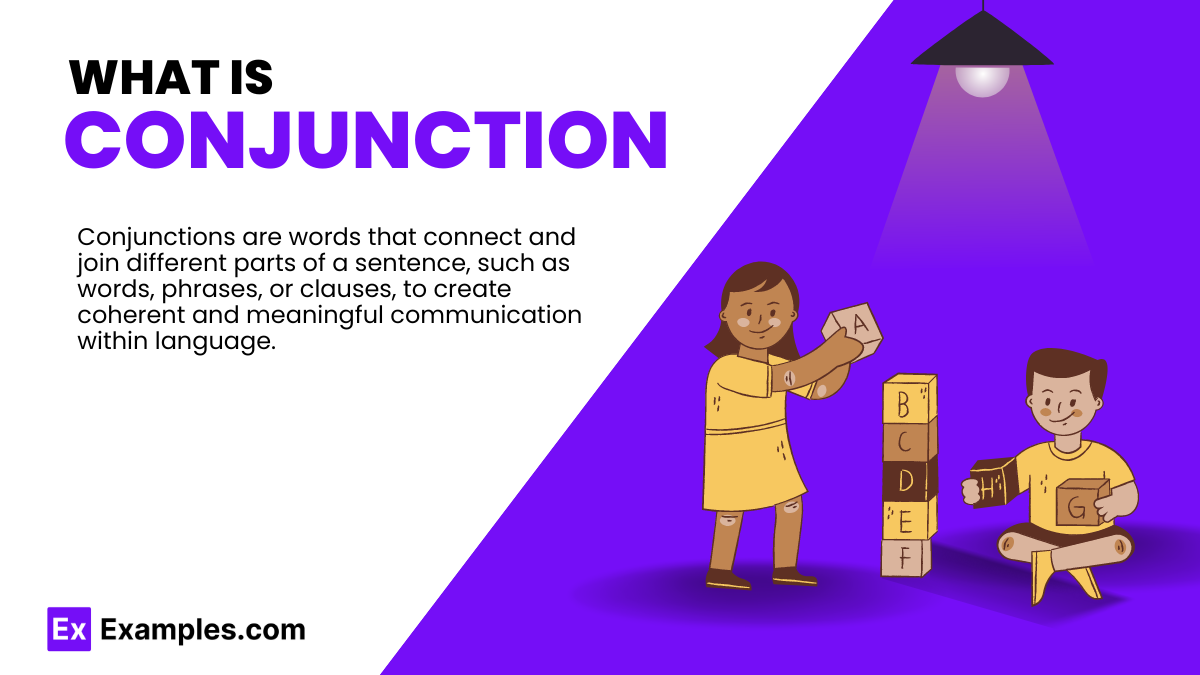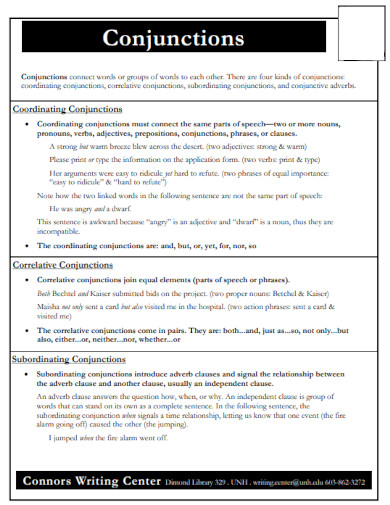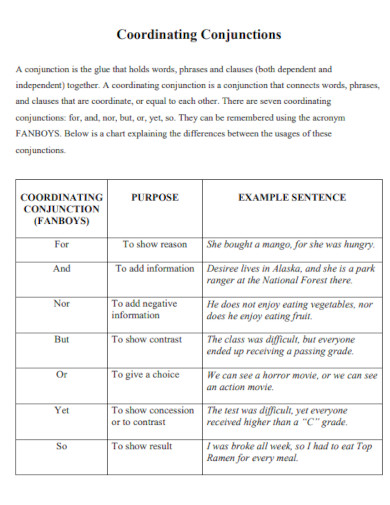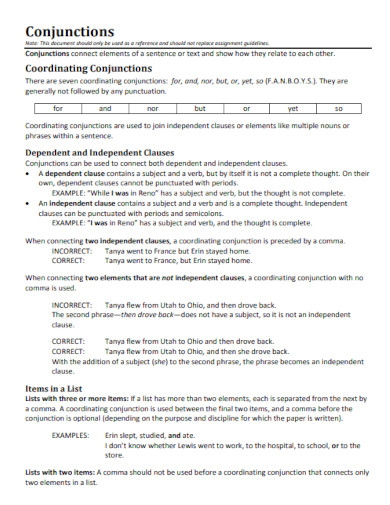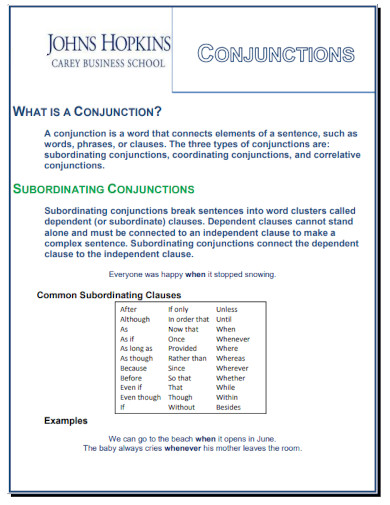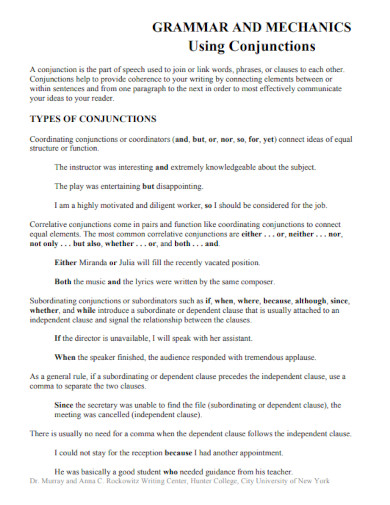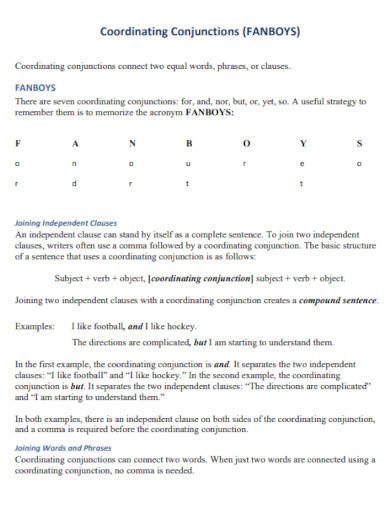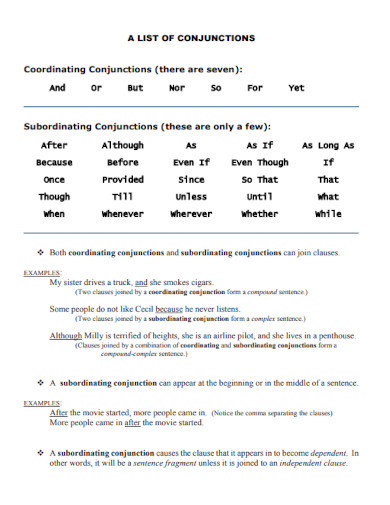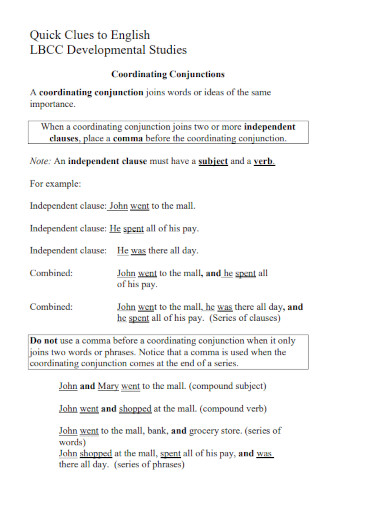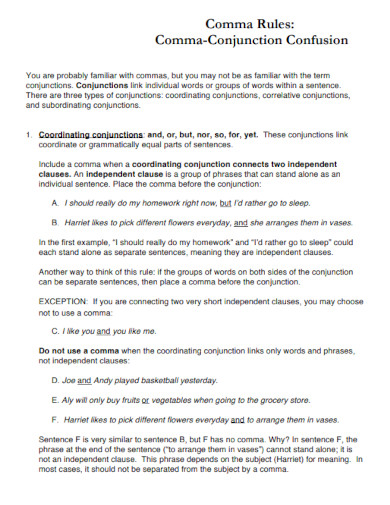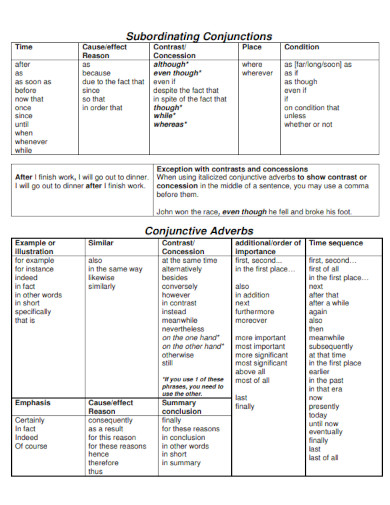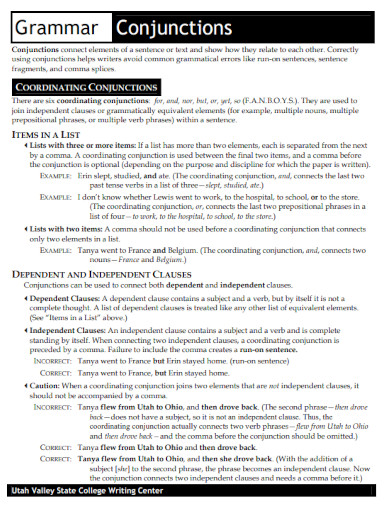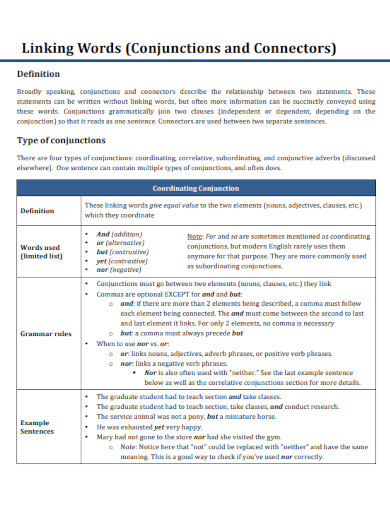99+ Conjunction Examples
Conjunctions serve as linguistic glue, binding words, phrases, or clauses together within sentences to express relationships and coherence. These small but pivotal parts of speech encompass coordinating, subordinating, and correlative conjunctions. Coordinating conjunctions such as “and,” “but,” and “or” link elements of equal importance, fostering balance and clarity. Subordinating conjunctions like “although” and “because” establish hierarchical relationships, indicating dependence or causation. Correlative conjunctions, such as “either…or” and “neither…nor,” work in pairs to emphasize choices or exclusions. Across languages, conjunctions play a vital role in structuring communication, imparting flow, cohesion, and precision to expression.
What is a Conjunction?
A conjunction is a part of speech that connects words, phrases, or clauses in a sentence. It facilitates coherence and logical relationships within language. Coordinating conjunctions like “and,” “but,” and “or” join elements of equal importance, while subordinating conjunctions like “although” and “because” indicate dependence or causation. Conjunctions are essential for structuring and conveying meaning in communication.
Purpose of Conjunctions
The purpose of conjunctions is to join words, phrases, or clauses together to create coherent and meaningful sentences. By facilitating connections between different parts of speech, conjunctions help to structure language, convey relationships, and clarify the meaning of a sentence.
-
Facilitating Connection: Conjunctions act as linguistic bridges, linking elements within a sentence to form complete thoughts. They enable writers and speakers to express complex ideas by connecting related concepts.
-
Structuring Language: Conjunctions contribute to the organization and flow of language, ensuring that sentences are well-formed and easy to understand. They help to create a logical structure by indicating relationships between different parts of a sentence.
-
Conveying Relationships: Different types of conjunctions convey various relationships between the connected elements. Coordinating conjunctions join elements of equal importance, while subordinating conjunctions establish dependencies or introduce subordinate clauses. Correlative conjunctions emphasize parallelism or choices.
-
Enhancing Clarity: By connecting related ideas and indicating the structure of a sentence, conjunctions enhance the clarity of communication. They help to avoid ambiguity and ensure that the intended meaning is conveyed accurately.
Types of Conjunctions
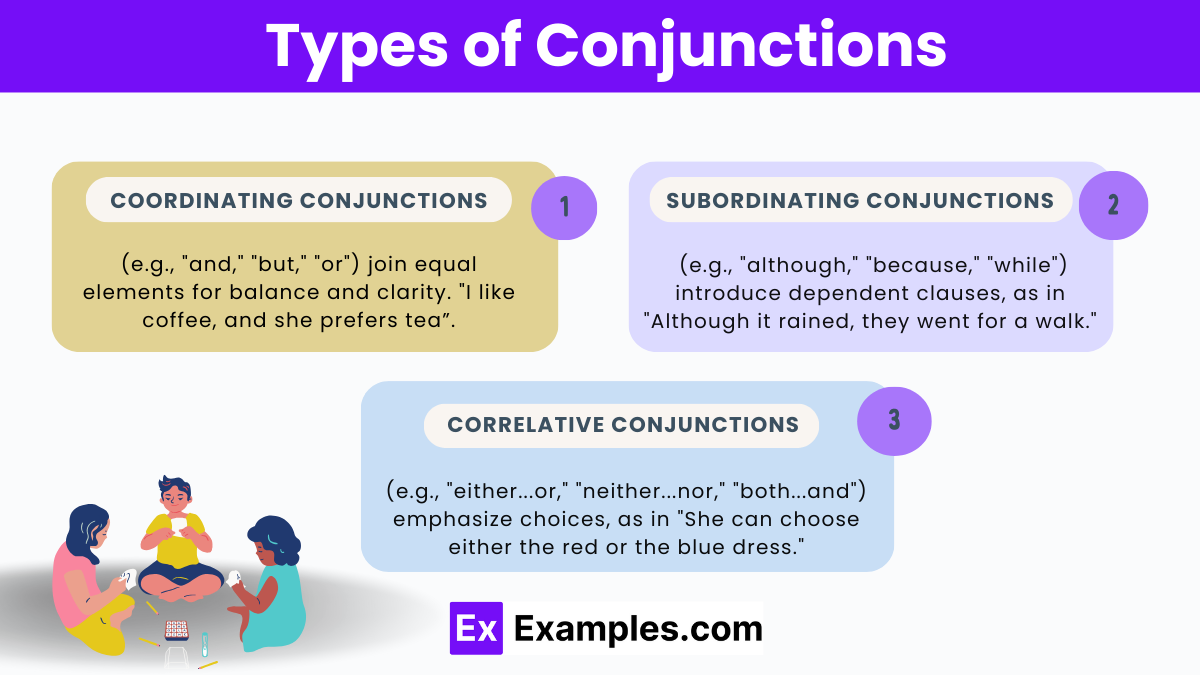
Conjunctions are the unsung heroes of language, seamlessly connecting words, phrases, and clauses to convey meaning and coherence. Understanding the different types of conjunctions is key to mastering language structure and communication. In this comprehensive guide, we delve into the various categories of conjunctions and their functions, providing clarity and insight for writers and language enthusiasts alike.
- Coordinating Conjunctions: Coordinating conjunctions, such as “and,” “but,” and “or,” are the workhorses of sentence structure. They join words, phrases, or clauses of equal importance, fostering balance and clarity in expression. For example, “I like coffee, and she prefers tea,” illustrates the use of “and” to connect two independent clauses.
- Subordinating Conjunctions: Subordinating conjunctions introduce dependent clauses, indicating a subordinate relationship to the main clause. These conjunctions, including “although,” “because,” and “while,” establish connections of time, cause, contrast, and condition. For instance, “Although it was raining, they decided to go for a walk,” showcases the subordinating conjunction “although” introducing the dependent clause.
- Correlative Conjunctions: Correlative conjunctions come in pairs and work together to connect similar grammatical elements. Examples include “either…or,” “neither…nor,” “both…and,” and “not only…but also.” These conjunctions emphasize choices, exclusions, or parallelism in sentences. “She can either choose the red dress or the blue one,” demonstrates the use of “either…or” to present alternatives.
Conjunction Rules
Here are some essential rules governing the use of conjunctions in English:
- Coordinating Conjunctions:
- Rule 1: Use coordinating conjunctions to join words, phrases, or clauses of equal importance.
- Example: “I like coffee and tea.”
- Common coordinating conjunctions: “and,” “but,” “or,” “nor,” “for,” “yet,” “so.”
- Subordinating Conjunctions:
- Rule 2: Use subordinating conjunctions to introduce dependent clauses, which cannot stand alone as complete sentences.
- Example: “She went to bed because she was tired.”
- Common subordinating conjunctions: “because,” “although,” “if,” “since,” “when,” “while,” “until,” “though.”
- Correlative Conjunctions:
- Rule 3: Use correlative conjunctions in pairs to join similar grammatical elements.
- Example: “You can have either the blue shirt or the red one.”
- Common correlative conjunctions: “either…or,” “neither…nor,” “both…and,” “not only…but also.”
- Parallelism:
- Rule 4: Maintain parallel structure when using correlative conjunctions or coordinating conjunctions in lists.
- Example: “She enjoys reading novels, writing poetry, and painting landscapes.”
- Ensure that all items in the list have the same grammatical structure.
- Comma Usage:
- Rule 5: Use a comma before a coordinating conjunction when joining independent clauses.
- Example: “He wanted to go for a walk, but it was raining.”
- No comma is needed if the clauses are short and closely related.
- Avoiding Run-on Sentences:
- Rule 6: Avoid creating run-on sentences by properly using conjunctions to connect independent clauses or by using appropriate punctuation.
- Example: Incorrect: “She went to the store she bought some groceries.” Correct: “She went to the store, and she bought some groceries.”
Components of Conjunction
Conjunctions are simple yet essential components of language, typically consisting of the following elements:
- Words: Conjunctions are made up of specific words or pairs of words that serve as connectors within sentences. These words include coordinating conjunctions like “and,” “but,” “or,” subordinating conjunctions like “because,” “although,” “while,” and correlative conjunction pairs like “either…or,” “neither…nor.”
- Phrases: Conjunctions can also be formed from longer phrases that function as connectors. For example, “as long as,” “in order that,” and “provided that” are examples of multi-word subordinating conjunctions.
- Function: The primary function of a conjunction is to join different elements of a sentence, such as words, phrases, or clauses, to create grammatically correct and meaningful structures. They establish relationships between these elements, indicating connections like addition, contrast, causation, condition, or choice.
- Position: Conjunctions can appear at various positions within a sentence, depending on the type of conjunction and its function. Coordinating conjunctions typically appear between the elements they connect, while subordinating conjunctions introduce dependent clauses at the beginning or within a sentence. Correlative conjunctions are usually found in pairs, with each part connecting corresponding elements.
- Impact on Sentence Structure: Conjunctions play a crucial role in shaping the structure and flow of sentences. They help organize ideas, establish logical relationships between clauses, and maintain coherence and clarity in communication. The correct use of conjunctions ensures that sentences are grammatically correct and convey the intended meaning effectively.
Conjunction Examples:
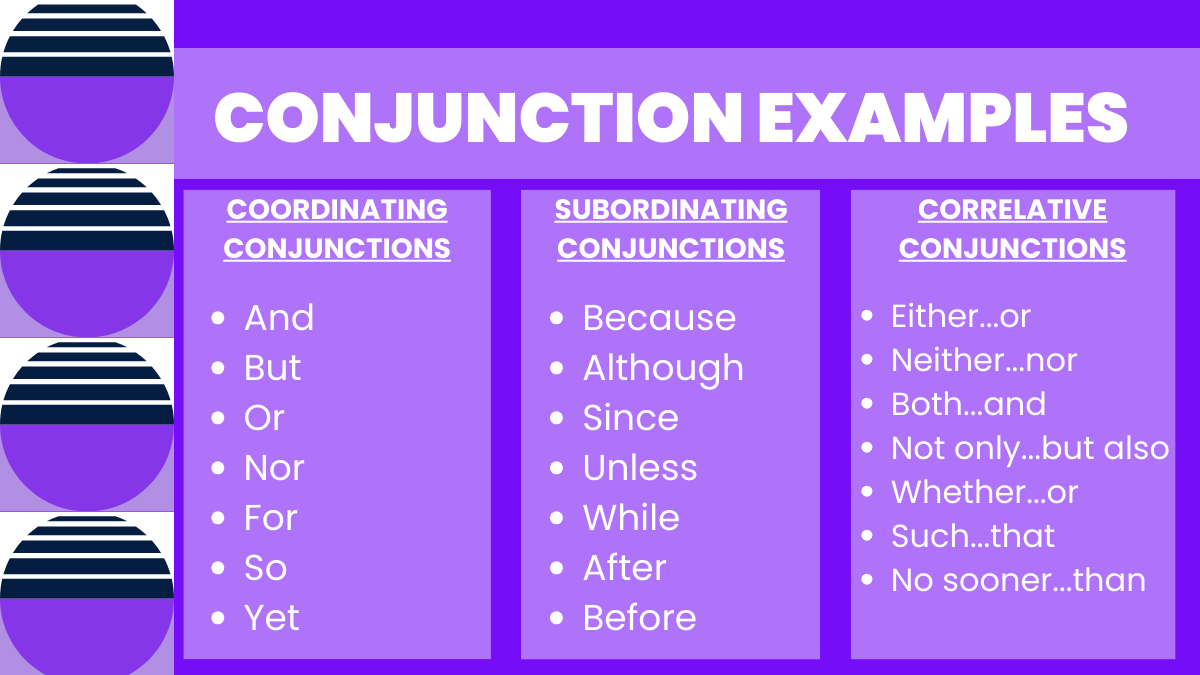
Most common Conjunctions
The most common conjunctions in English include:
- Coordinating Conjunctions:
- And: Used to add information or join similar elements.
- But: Indicates contrast or opposition.
- Or: Presents alternatives or options.
- Nor: Used to connect negative alternatives.
- For: Explains a reason or cause.
- Yet: Indicates contrast or unexpectedness.
- So: Shows result, consequence, or purpose.
- Subordinating Conjunctions:
- Because: Introduces a reason or cause.
- Although/Though: Indicates contrast or concession.
- If: Introduces a condition.
- While: Indicates simultaneous action or contrast.
- Since: Introduces a reason or time frame.
- Until: Indicates time or condition before something happens.
- When: Indicates time or condition.
- Correlative Conjunctions:
- Either…or: Indicates a choice between two options.
- Neither…nor: Indicates exclusion of both options.
- Both…and: Indicates inclusion of two options.
- Not only…but also: Emphasizes addition or contrast.
Conjunction Words
Coordinating Conjunctions:
- And: Joins two elements together, indicating addition or continuation. Example: “Apples and oranges.”
- But: Connects contrasting ideas or clauses. Example: “She likes tea, but he prefers coffee.”
- Or: Presents alternatives or options. Example: “You can have cake or ice cream.”
- Nor: Used to connect two negative alternatives. Example: “He neither eats meat nor fish.”
- For: Explains a reason or cause. Example: “She is tired, for she stayed up late.”
- Yet: Indicates contrast or unexpectedness. Example: “He is tired, yet he refuses to sleep.”
- So: Shows result, consequence, or purpose. Example: “It was raining, so we stayed indoors.”
- Because: Introduces a reason or cause. Example: “They went to the park because it was sunny.”
- Either: Introduces one of two alternatives. Example: “You can either come now or wait until later.”
- Nor: Used in negative sentences to add another negative condition. Example: “He doesn’t like tea, nor does he like coffee.”
Subordinating Conjunctions:
- Although: Introduces a contrast or concession. Example: “She went out, although it was raining.”
- Because: Introduces a reason or cause. Example: “He left early because he had to catch a train.”
- While: Indicates simultaneous action or contrast. Example: “She read a book while waiting for the bus.”
- If: Introduces a condition. Example: “I will go for a walk if the weather is nice.”
- Since: Introduces a reason or time frame. Example: “He has been studying English since he was a child.”
- Unless: Indicates a condition that must be met for something to happen. Example: “He won’t go outside unless it stops raining.”
- Whereas: Indicates a contrast between two clauses. Example: “She likes coffee, whereas he prefers tea.”
- After: Indicates the time when something happens. Example: “They went to bed after watching a movie.”
- Though: Introduces a concession or contrast. Example: “She is happy, though she didn’t win the game.”
- Until: Indicates the time when something ends or begins. Example: “She will wait until he arrives.”
Correlative Conjunctions:
- Either…or: Presents a choice between two alternatives. Example: “Either you come with us, or you stay here.”
- Neither…nor: Indicates the exclusion of two alternatives. Example: “She is neither tall nor short.”
- Both…and: Indicates the inclusion of two alternatives. Example: “She is both smart and kind.”
- Not only…but also: Emphasizes addition or contrast. Example: “He is not only intelligent, but also hardworking.”
- Whether…or: Presents a choice between two alternatives. Example: “I don’t know whether to laugh or cry.”
- As…as: Indicates equality or comparison. Example: “He is as tall as his brother.”
- So…that: Indicates the result of an action. Example: “She was so tired that she fell asleep immediately.”
- Such…that: Emphasizes the extent or degree of something. Example: “It was such a hot day that they went swimming.”
- Just as…so: Indicates a cause and effect relationship. Example: “Just as he arrived, so did the rain.”
- Whether…or not: Indicates uncertainty or possibility. Example: “She will go whether you like it or not.”
Examples of Conjunction in Sentences
Coordinating Conjunctions:
- And: She likes to read and write in her free time.
- But: He wanted to go to the party, but he had too much work to do.
- Or: Do you want tea or coffee for breakfast?
- Nor: He neither ate nor slept the entire night.
- For: She wanted to study abroad, for it would broaden her horizons.
- Yet: She studied hard, yet she failed the exam.
- So: It was raining, so we decided to stay indoors.
- Because: He was hungry because he hadn’t eaten all day.
- Either: You can either come with us or stay here.
- Nor: She doesn’t like tea, nor does she like coffee.
Subordinating Conjunctions:
- Although: Although it was raining, they decided to go for a walk.
- Because: He left early because he had a meeting.
- While: She listened to music while doing her homework.
- If: If you study hard, you will pass the exam.
- Since: He has been practicing soccer since he was a child.
- Unless: He won’t go outside unless it stops raining.
- Whereas: She likes coffee, whereas he prefers tea.
- After: They went to bed after watching a movie.
- Though: She is happy, though she didn’t win the game.
- Until: She will wait until he arrives.
Correlative Conjunctions:
- Either…or: You can either come with us or stay here.
- Neither…nor: She is neither tall nor short.
- Both…and: She is both smart and kind.
- Not only…but also: He is not only intelligent, but also hardworking.
- Whether…or: I don’t know whether to laugh or cry.
- As…as: He is as tall as his brother.
- So…that: She was so tired that she fell asleep immediately.
- Such…that: It was such a hot day that they went swimming.
- Just as…so: Just as he arrived, so did the rain.
- Whether…or not: She will go whether you like it or not.
More Conjunctions Samples & Examples:
1. Conjunction Sample
2. Coordinating Conjunction
3. Conjunction Document
4. What is Conjunction
5. Conjunctions with Grammar
6. Types of Conjunction
7. Conjunction PDF
8. List of Conjunction
9. The Conjunction
10. Conjunction English
11. Conjunction Format
12. Comma Conjunction Confusion
13. Subordinating Conjunction
14. Grammar Conjunction Example
15. Conjunctions and Connectors
How to Make Conjunction Sentences
We know that coordinating conjunctions help in making our sentences make more sense. It helps in a way that it connects different words or phrases to complete the sentence. With that in mind, you may find making conjunction sentences easier when you have the idea in mind. With that being said, here are some ways on making a conjunction sentence.
Step 1. Follow the Format of FANBOYS
You may have heard of the acronym FANBOYS coordinating conjunctions in sentences. The acronym FANBOYS means for, and, nor, but, or, yet and so. These are the most common conjunctions that are used in order to formulate and connect your sentences. When you want to write a sentence with a conjunction, all you have to do is remember the acronym FANBOYS.
Step 2. Using the Different Fanboys Conjunction
Each conjunction has its own purpose and uses when making your sentences. When you use the conjunction “for” you are letting your readers know that you were being cautious. The conjunctions and, nor and but have a different set of rules when you use them in a sentence. When you use “and” you are mixing two things together that may or may not be related to one another.
Step 3. The Conjunctions Nor, But, Or, Yet, and So
Using “nor” in a sentence means that something you are talking about is negative. “But” states to your readers that you are contradicting two things in the sentence. Using the “or” means you are giving options. “Yet” acts like the conjunction but, and the phrase that they are referring to. “So” this conjunction states the reason for being cautious. It describes or it shows the effect of being cautious.
Step 4. Remembering the Fanboys Acronym to Making Sentences
Lastly, remembering the fanboys acronym to making sentences will help you succeed in the long run. Though it may sound and look difficult at first, but the hint or the key to it is to remember their simple uses.
What is a conjunction?
A conjunction is a word that connects clauses, sentences, or words within the same clause, such as “and,” “but,” “or,” and “so.”
What are the types of conjunctions?
The three main types are coordinating, subordinating, and correlative conjunctions, each serving to link different elements in sentences.
What are coordinating conjunctions?
Coordinating conjunctions connect words, phrases, or independent clauses of equal importance. Examples include “and,” “but,” “or,” “nor,” “for,” “so,” and “yet.”
What are subordinating conjunctions?
Subordinating conjunctions connect an independent clause with a dependent clause, examples include “because,” “although,” “since,” “unless,” and “while.”
What are correlative conjunctions?
Correlative conjunctions work in pairs to link related elements within a sentence. Examples include “either…or,” “neither…nor,” and “both…and.”
Can you start a sentence with a conjunction?
Yes, you can start a sentence with a conjunction to add emphasis or create a smoother transition between ideas, though it should be done sparingly.
What is the function of conjunctions?
Conjunctions join words, phrases, or clauses, showing the relationship between them and helping to create complex, coherent sentences.
How do you use “and” correctly?
Use “and” to connect similar ideas or items in a list. Ensure that the elements joined by “and” are parallel in structure.
What is the difference between “but” and “yet”?
“But” and “yet” both show contrast, but “yet” often implies a surprising or unexpected outcome, whereas “but” is used for straightforward opposition.
How do conjunctions improve writing?
Conjunctions enhance writing by linking ideas smoothly, creating more complex sentences, and clarifying relationships between thoughts, making text more coherent and engaging.



